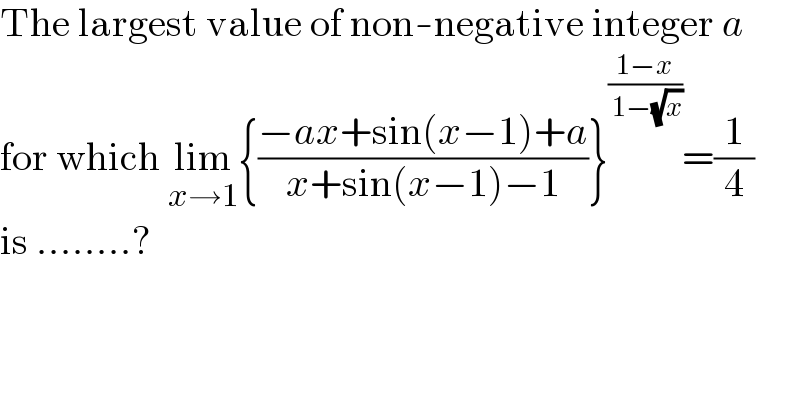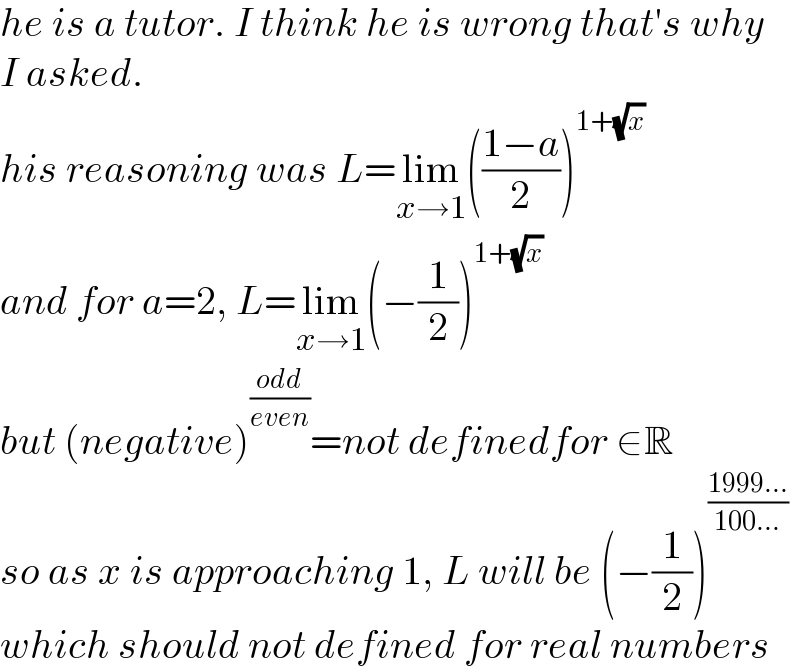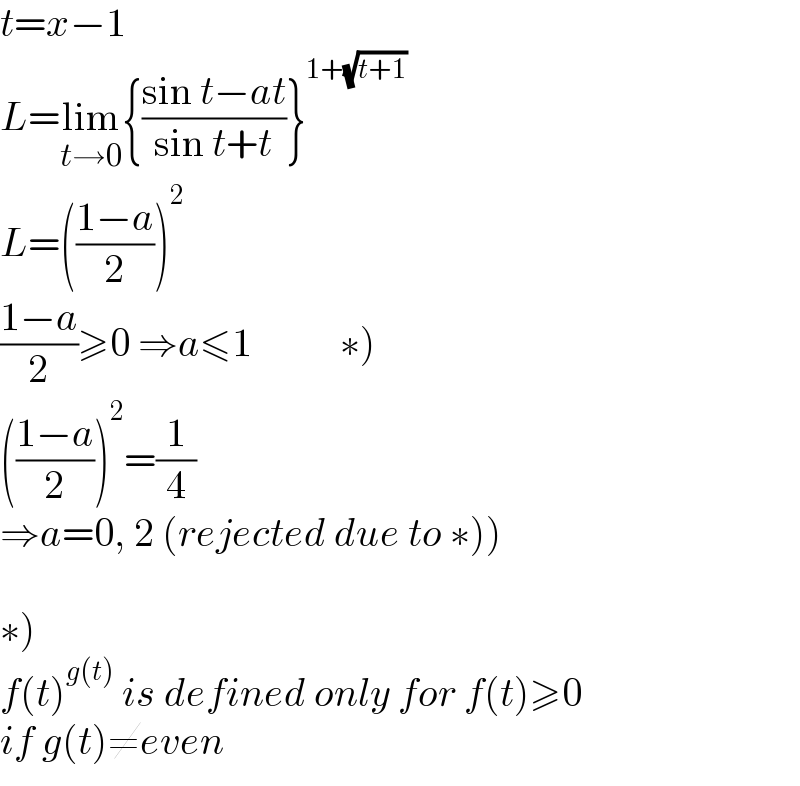
Question Number 160065 by Kunal12588 last updated on 24/Nov/21

$$\mathrm{The}\:\mathrm{largest}\:\mathrm{value}\:\mathrm{of}\:\mathrm{non}-\mathrm{negative}\:\mathrm{integer}\:{a} \\ $$$$\mathrm{for}\:\mathrm{which}\:\underset{{x}\rightarrow\mathrm{1}} {\mathrm{lim}}\left\{\frac{−{ax}+\mathrm{sin}\left({x}−\mathrm{1}\right)+{a}}{{x}+\mathrm{sin}\left({x}−\mathrm{1}\right)−\mathrm{1}}\right\}^{\frac{\mathrm{1}−{x}}{\:\mathrm{1}−\sqrt{{x}}}} =\frac{\mathrm{1}}{\mathrm{4}} \\ $$$$\mathrm{is}\:........? \\ $$
Commented by Kunal12588 last updated on 24/Nov/21

$${it}\:{gives}\:{a}=\mathrm{0},\mathrm{2}\:{but}\:{they}\:{are}\:{saying}\:{a}=\mathrm{2}\:{is}\:{invalid} \\ $$$$\mathrm{How}\:\mathrm{is}\:{a}=\mathrm{2}\:\mathrm{invalid}? \\ $$
Commented by Kunal12588 last updated on 24/Nov/21

$${he}\:{is}\:{a}\:{tutor}.\:{I}\:{think}\:{he}\:{is}\:{wrong}\:{that}'{s}\:{why}\: \\ $$$${I}\:{asked}. \\ $$$${his}\:{reasoning}\:{was}\:{L}=\underset{{x}\rightarrow\mathrm{1}} {\mathrm{lim}}\left(\frac{\mathrm{1}−{a}}{\mathrm{2}}\right)^{\mathrm{1}+\sqrt{{x}}} \\ $$$${and}\:{for}\:{a}=\mathrm{2},\:{L}=\underset{{x}\rightarrow\mathrm{1}} {\mathrm{lim}}\left(−\frac{\mathrm{1}}{\mathrm{2}}\right)^{\mathrm{1}+\sqrt{{x}}} \\ $$$${but}\:\left({negative}\right)^{\frac{{odd}}{{even}}} ={not}\:{definedfor}\:\in\mathbb{R} \\ $$$${so}\:{as}\:{x}\:{is}\:{approaching}\:\mathrm{1},\:{L}\:{will}\:{be}\:\left(−\frac{\mathrm{1}}{\mathrm{2}}\right)^{\frac{\mathrm{1999}...}{\mathrm{100}...}} \\ $$$${which}\:{should}\:{not}\:{defined}\:{for}\:{real}\:{numbers} \\ $$
Commented by Kunal12588 last updated on 24/Nov/21
so what do you think? a=2 is valid or not?
Commented by mr W last updated on 24/Nov/21

$${i}\:{changed}\:{my}\:{mind}.\:{they}\:{are}\:{right}. \\ $$$${see}\:{below}. \\ $$
Commented by Kunal12588 last updated on 24/Nov/21

$${sir}\:{does}\:{this}\:{mean}\:{when}\:{a}\:=\:\mathrm{2},\:{L}\neq\frac{\mathrm{1}}{\mathrm{4}} \\ $$
Commented by Kunal12588 last updated on 24/Nov/21

Commented by mr W last updated on 24/Nov/21
![for x, y ∈R, with a=2 y=f(x)=[((sin (x−1)−2(x−1))/(sin (x−1)+(x−1)))]^(1+(√x)) is not defined. so limit lim_(x→1) f(x) doesn′t exist. in wolfram alpha, y∈C. therefore you should define if you have to do with real functions or with complex functions.](Q160097.png)
$${for}\:{x},\:{y}\:\in{R},\:{with}\:{a}=\mathrm{2} \\ $$$${y}={f}\left({x}\right)=\left[\frac{\mathrm{sin}\:\left({x}−\mathrm{1}\right)−\mathrm{2}\left({x}−\mathrm{1}\right)}{\mathrm{sin}\:\left({x}−\mathrm{1}\right)+\left({x}−\mathrm{1}\right)}\right]^{\mathrm{1}+\sqrt{{x}}} \\ $$$${is}\:{not}\:{defined}.\:{so}\:{limit}\:\underset{{x}\rightarrow\mathrm{1}} {\mathrm{lim}}{f}\left({x}\right) \\ $$$${doesn}'{t}\:{exist}. \\ $$$$ \\ $$$${in}\:{wolfram}\:{alpha},\:{y}\in{C}. \\ $$$$ \\ $$$${therefore}\:{you}\:{should}\:{define}\:{if}\:{you} \\ $$$${have}\:{to}\:{do}\:{with}\:{real}\:{functions}\:{or} \\ $$$${with}\:{complex}\:{functions}. \\ $$
Commented by Kunal12588 last updated on 24/Nov/21

$${thank}\:{you}\:{sir} \\ $$
Answered by mr W last updated on 24/Nov/21

$${t}={x}−\mathrm{1} \\ $$$${L}=\underset{{t}\rightarrow\mathrm{0}} {\mathrm{lim}}\left\{\frac{\mathrm{sin}\:{t}−{at}}{\mathrm{sin}\:{t}+{t}}\right\}^{\mathrm{1}+\sqrt{{t}+\mathrm{1}}} \\ $$$${L}=\left(\frac{\mathrm{1}−{a}}{\mathrm{2}}\right)^{\mathrm{2}} \\ $$$$\left.\frac{\mathrm{1}−{a}}{\mathrm{2}}\geqslant\mathrm{0}\:\Rightarrow{a}\leqslant\mathrm{1}\:\:\:\:\:\:\:\:\:\:\:\ast\right) \\ $$$$\left(\frac{\mathrm{1}−{a}}{\mathrm{2}}\right)^{\mathrm{2}} =\frac{\mathrm{1}}{\mathrm{4}} \\ $$$$\left.\Rightarrow{a}=\mathrm{0},\:\mathrm{2}\:\left({rejected}\:{due}\:{to}\:\ast\right)\right) \\ $$$$ \\ $$$$\left.\ast\right) \\ $$$${f}\left({t}\right)^{{g}\left({t}\right)} \:{is}\:{defined}\:{only}\:{for}\:{f}\left({t}\right)\geqslant\mathrm{0} \\ $$$${if}\:{g}\left({t}\right)\neq{even} \\ $$
